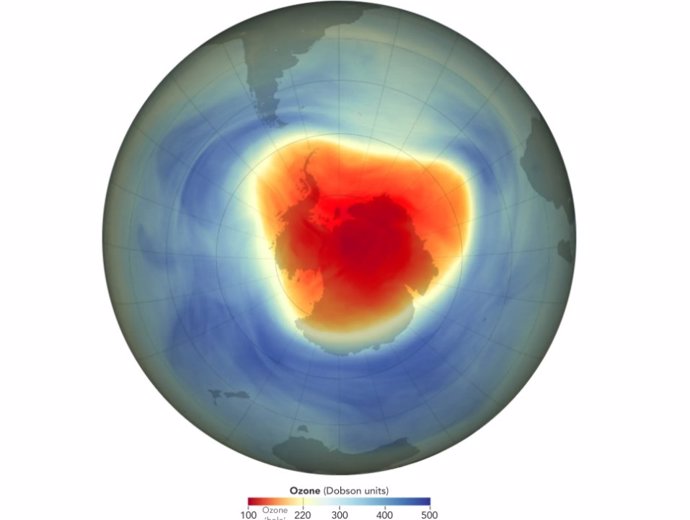This map shows the size and shape of the ozone hole over the South Pole on September 28, 2024, the day of its annual maximum extent, as calculated by NASA’s Ozone Watch team. -NASA
Oct. 31 () –
Recovery continues in the atmosphere over Antarctica: a hole that opens annually in the ozone layer over the South Pole was relatively small in 2024 compared to other years.
This is estimated by scientists from NASA and the National Oceanic and Atmospheric Administration (NOAA), who project that the ozone layer could fully recover in 2066.
During the peak of the ozone depletion season, from September 7 to October 13, the area of the ozone hole in 2024 was ranked as the seventh smallest since recovery began in 1992, when the Protocol Montreal, a landmark international agreement to phase out ozone-depleting chemicals, began to come into force.
THREE TIMES UNITED STATES
At nearly 20 million square kilometers, the average monthly ozone-depleted region in Antarctica this year was nearly three times the size of the continental United States. The hole reached its largest single-day extent for the year on September 28, at 22.4 million square kilometers.
According to scientists, the improvement is due to a combination of continued declines in harmful chlorofluorocarbon (CFC) chemicals, along with an unexpected infusion of ozone carried by northern Antarctic air currents.
In previous years, NASA and NOAA have reported ozone hole classification using a time frame dating back to 1979, when scientists began tracking Antarctic ozone levels with satellite data. Using that longer record, This year’s hole ranked 20th smallest in surface area across 45 years of observations.
GRADUAL IMPROVEMENT IN THE LAST TWO DECADES
“The 2024 Antarctic hole is smaller than the ozone holes observed in the early 2000s,” he said. in a statement Paul Newman, leader of NASA’s ozone research team and chief scientist for Earth sciences at NASA’s Goddard Space Flight Center in Greenbelt, Maryland. “The gradual improvement we have seen over the past two decades shows that international efforts to curb ozone-depleting chemicals are working.”
The ozone-rich layer high in the atmosphere acts as a planetary sunscreen, helping to protect us from the sun’s harmful ultraviolet (UV) radiation. Areas with depleted ozone allow greater UV radiation, resulting in increased cases of skin cancer and cataracts. Excessive exposure to UV light can also reduce agricultural yields, as well as harm aquatic plants and animals in vital ecosystems.
In the 1970s, scientists became alarmed at the prospect that CFCs could erode atmospheric ozone.. By the mid-1980s, the ozone layer had depleted so much that a wide swath of the Antarctic stratosphere was virtually devoid of ozone by early October each year. Sources of harmful CFCs included refrigerants in refrigerators and air conditioners, as well as aerosols in hairspray, antiperspirants, and spray paint. Harmful chemicals were also released in the manufacture of insulating foams and as components of industrial fire suppression systems.
The Montreal Protocol was signed in 1987 to phase out CFC-based products and processes. Countries around the world agreed to replace chemicals with more environmentally friendly alternatives by 2010. The release of CFC compounds has decreased dramatically after the Montreal Protocol. But CFCs already in the air will take many decades to decompose. As existing CFC levels gradually decline, ozone in the upper atmosphere will recover globally and ozone holes will shrink.
“By 2024, we can see that the severity of the ozone hole is below average compared to other years in the last three decades, but the ozone layer is still far from being completely cured“said Stephen Montzka, senior scientist at NOAA’s Global Monitoring Laboratory.















![[Img #74664]](https://thelatestnews.world/wp-content/uploads/2024/12/James-Watson-The-controversial-genius-behind-the-double-helix-300x200.jpg)
Add Comment